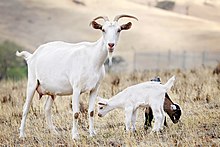
Back Reproducción de los mamíferos Spanish تولیدمثل پستانداران Persian Sinh sản ở loài thú Vietnamese

Most mammals are viviparous, giving birth to live young.[1] However, the five species of monotreme, the platypuses and the echidnas, lay eggs. The monotremes have a sex determination system different from that of most other mammals.[2] In particular, the sex chromosomes of a platypus are more like those of a chicken than those of a therian mammal.[3]
The mammary glands of mammals are specialized to produce milk, a liquid used by newborns as their primary source of nutrition. The monotremes branched early from other mammals and do not have the teats seen in most mammals, but they do have mammary glands. The young lick the milk from a mammary patch on the mother's belly.
Viviparous mammals are in the subclass Theria; those living today are in the Marsupialia and Placentalia infraclasses. A marsupial has a short gestation period, typically shorter than its estrous cycle, and gives birth to an underdeveloped (altricial) newborn that then undergoes further development; in many species, this takes place within a pouch-like sac, the marsupium, located in the front of the mother's abdomen. Some placentals, e.g. guinea pig, give birth to fully developed (precocial) young, usually after long gestation periods, while some others, e.g. mouse, give birth to underdeveloped young.
- ^ Preston, Elizabeth (13 February 2024). "Self-Love Is Important, but We Mammals Are Stuck With Sex - Some female birds, reptiles and other animals can make a baby on their own. But for mammals like us, eggs and sperm need each other". The New York Times. Archived from the original on 13 February 2024. Retrieved 16 February 2024.
- ^ Wallis MC, Waters PD, Delbridge ML, Kirby PJ, Pask AJ, Grützner F, Rens W, Ferguson-Smith MA, Graves JA, et al. (2007). "Sex determination in platypus and echidna: autosomal location of SOX3 confirms the absence of SRY from monotremes". Chromosome Research. 15 (8): 949–959. doi:10.1007/s10577-007-1185-3. PMID 18185981. S2CID 812974.
- ^ Marshall Graves, Jennifer A. (2008). "Weird Animal Genomes and the Evolution of Vertebrate Sex and Sex Chromosomes" (PDF). Annual Review of Genetics. 42: 568–586. doi:10.1146/annurev.genet.42.110807.091714. PMID 18983263. Archived from the original (PDF) on 2012-09-04.
© MMXXIII Rich X Search. We shall prevail. All rights reserved. Rich X Search